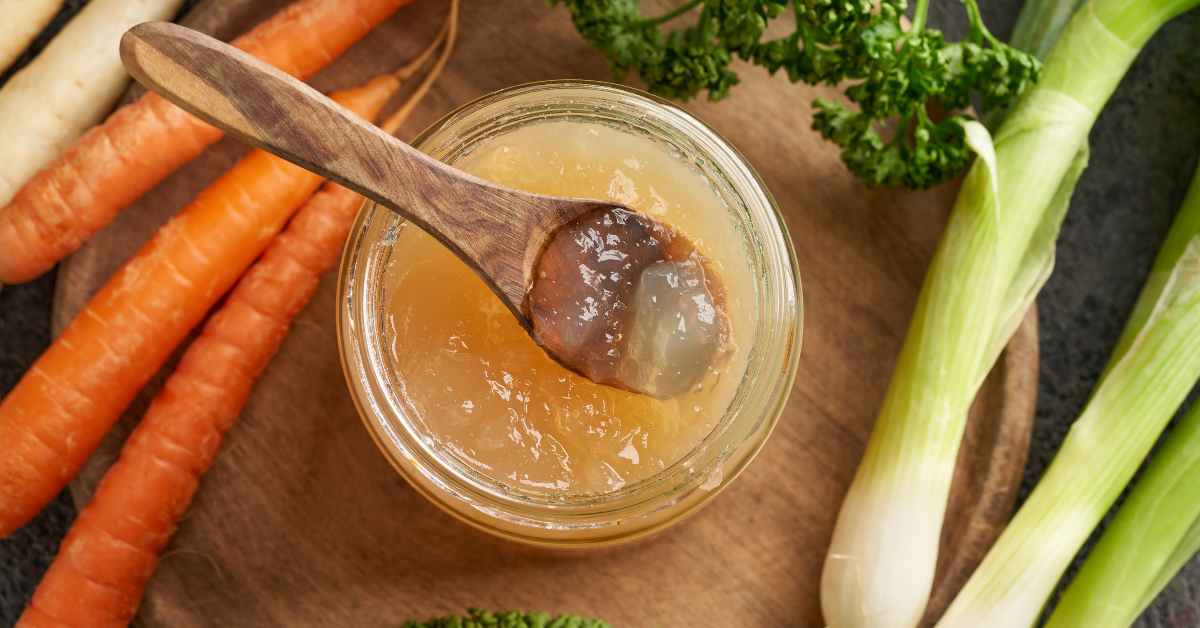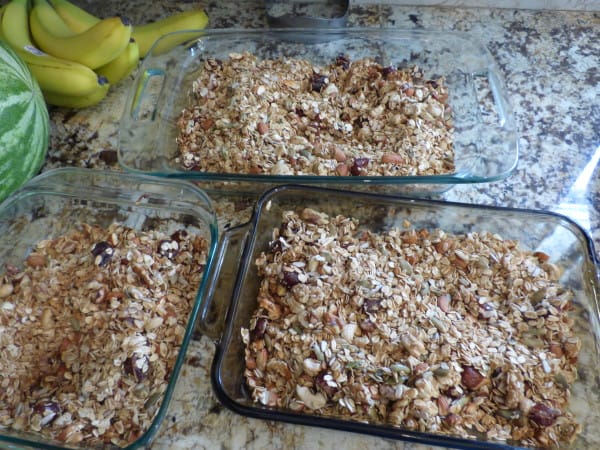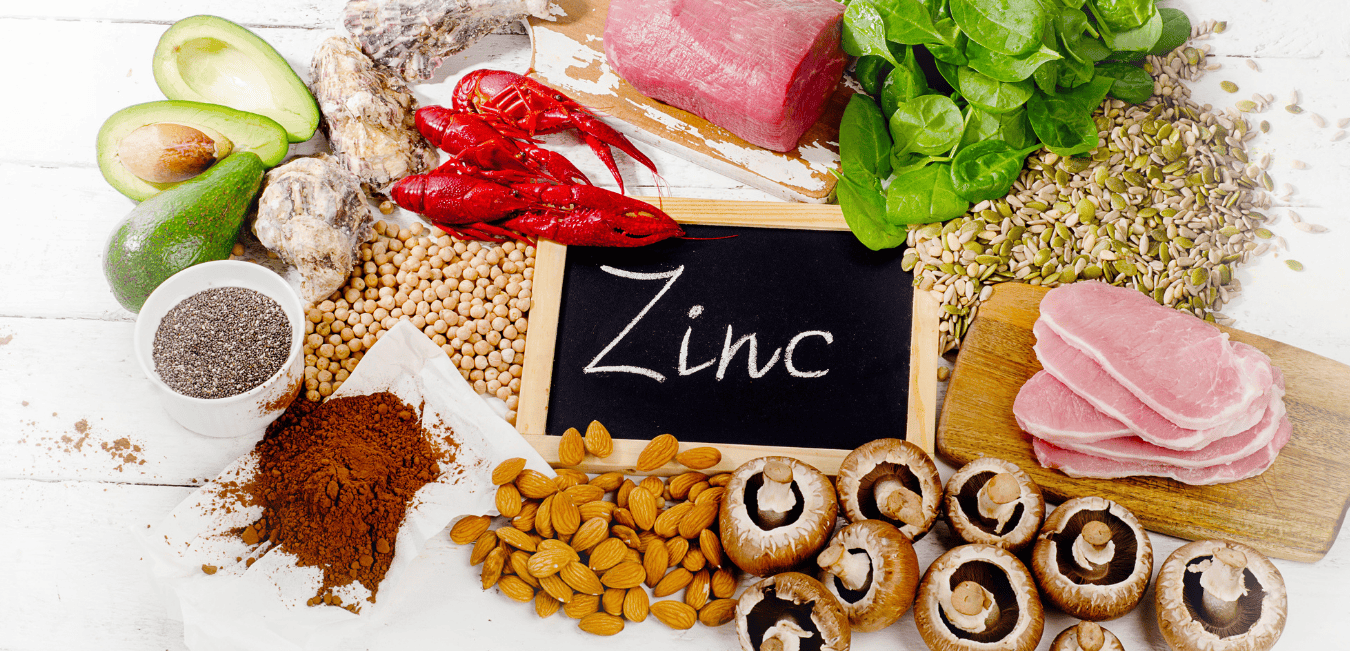Bone broth is a traditional food that is rivaled perhaps only by sourdough bread in terms of trendiness. However, because bone broth is a nutritional powerhouse, this is one trend that I hope will remain in the spotlight! Bone broth can be integrated into a myriad of meals ranging from soups and stews to grain based dishes, and it is even an unexpected ingredient in some foods and beverages, like bone broth hot cocoa. The benefits associated with bone broth are thought to come from its collagen content and richness in certain electrolytes and amino acids.
In this article, you’ll gain insights into the nutritional benefits of bone broth and get a bone broth recipe with plenty of tips for tweaks and modifications. Plus, I’ll share some of my favorite ways to incorporate bone broth into kid-friendly foods and a note about bone broth considerations for those who struggle with high histamine foods.
What Is Bone Broth?
Bone broth is a protein-rich liquid made by simmering meaty joints and bones in water and can be made using almost any kind of bones, including beef, lamb, goat, bison, chicken, fish, or turkey bones. It is set apart from conventional stocks by its long slow-cooking process often lasting more than 12 hours. This extended simmering time extracts nutrients and collagen from the bones and tissue. Bone broth often has a gelatinous consistency at room temperature; the ‘jelliness’ is often regarded as a measurement of the gelatin content of the broth.
The Nutritional Benefits Of Bone Broth
Collagen & Gelatin Content
When making bone broth, the breakdown of bones during the slow cooking process releases collagen, a structural protein found in the connective tissues of the meat and bones, into the broth. 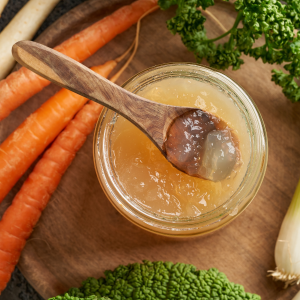 Collagen is a fibrous protein that provides strength and elasticity to skin, bones, tendons, and ligaments. When these collagen rich parts are subjected to heat, the long collagen molecules unwind and break down into smaller more soluble proteins, known as gelatin (1).
Collagen is a fibrous protein that provides strength and elasticity to skin, bones, tendons, and ligaments. When these collagen rich parts are subjected to heat, the long collagen molecules unwind and break down into smaller more soluble proteins, known as gelatin (1).
Integrating gelatin rich bone broth into the diet supports gut health by coating and fortifying the mucous lining (2). Collagen and gelatin are recognized as being supportive of joint health, facilitating the regeneration and repair of tissues essential for maintaining joint comfort (3,4). Collagen is also supportive of healthy skin, nails, and hair (5). Regular bone broth consumption is a great way to support these areas of health.
Amino Acids
Amino acids, essential components of proteins found in all protein-containing foods, include about 20 types with 9 being essential, meaning that the body cannot create them on their own and they must be consumed through dietary intake (6). Amino acids are vital for building muscles, facilitating chemical reactions, and supporting various bodily functions. Deficiency in essential amino acids can lead to health issues like decreased immunity, digestive problems, and mental alertness issues (7).
Though the exact content will vary depending on the ingredients used and the cooking method, bone broth is generally rich in several important amino acids, including glycine, proline, and arginine (8).
Glycine in bone broth supports collagen synthesis, promoting gut health and aiding digestive tract repair. It also influences neurotransmitter regulation, potentially improving sleep and cognitive function, while contributing to inflammation regulation (9).
Proline in bone broth contributes to collagen synthesis, promoting skin health. It aids in nutrient absorption and supports the immune system (10).
Arginine creates nitric oxide within the body for blood circulation and supports the immune system (11).
Hydration & Electrolytes
Bone broth, rich in electrolytes like potassium and sodium, contributes to maintaining a healthy fluid balance in the body (12). This balance is crucial for various physiological functions, including blood flow and clotting, muscle contractions, and acid balance. Electrolytes play a vital role in regulating chemical reactions and ensuring stability between fluids inside and outside of cells (13).
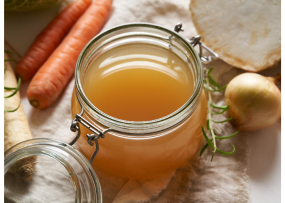 Dr Green Mom’s Bone Broth Recipe
Dr Green Mom’s Bone Broth Recipe
⏲️ Prep Time
10 Min.
⏲️ Cook Time
Up to 24 Hours
Ingredients
- Bones of choice (beef, poultry, fish, lamb, bison, elk, etc*). At least 1 lb of bones per 1 qt of water.
- Optional: Vegetable scraps (onion, celery, garlic, carrot, leaks, etc)
- Optional: Salt and pepper
- 1 tablespoon apple cider vinegar
- Filtered water or spring water. At least 1 qt of water per 1 lb of bones.
Directions
1. Prepare Bones (Optional)
If using raw bones, roasting them in the oven at 400°F (200°C) for about 30 minutes enhances flavor. Don’t do this if you want a neutral broth, like if you plan to use the broth to prepare bone broth hot chocolate, for example.
If using cooked bones (like leftover chicken or beef bones), skip this step.
2. Combine Ingredients In A Pot
Place the bones in a large stockpot, pressure cooker, slow cooker or Dutch oven.*
If desired, add the quartered onion, chopped carrots, celery, and smashed garlic to the pot.
Pour in the apple cider vinegar.
3. Simmer
Cover the pot and let broth simmer on low heat for at least 8 hours for chicken bones and up to 24 hours for beef bones. See below for details on cook time by bone type and cooking method.
4. Strain
Once broth is ready, strain the broth through a fine mesh strainer or cheesecloth into another pot or large bowl.
5. Season
Add salt and pepper, if desired.
6. Cool and Store
Allow broth to cool before refrigerating or freezing. As the broth cools, the fat will rise to the top and harden. Remove any congealed fat from the top before use or save it to make tallow.
Cooking Methods & Times
Bone broth should be kept at a low simmer. This can be achieved in a slow cooker on low, a stockpot on the stove set to low, or a dutch oven in the oven at 180°F. If you are using an Instant Pot, your cooking time will be much less, from 3-5 hours depending on the type of bones you are using. See cook time guidelines below.
1. Chicken Bone Broth
If slow cooking, simmer on the stove on low or in the oven at 180°F or in the slow cooker on low for 8-12 hours to extract flavors and nutrients effectively.
If using a pressure cooker, cook on high for 4 hours and allow pressure to release naturally.
Tip: Use the entire carcass after enjoying a roast chicken. Add chicken feet if available for a more gelatinous broth.
 2. Beef, Bison, Lamb, or Elk Bone Broth
2. Beef, Bison, Lamb, or Elk Bone Broth
If slow cooking, simmer on the stove on low or in the oven at 180°F or in the slow cooker on low for 12-24 hours to extract flavors and nutrients effectively.
If using a pressure cooker, cook on high for 6 hours and allow pressure to release naturally.
3. Fish Bone Broth
If slow cooking, simmer on the stove on low or in the oven at 180°F or in the slow cooker on low for 4 hours to extract flavors and nutrients.
If using a pressure cooker, cook on high for 2 hours and allow pressure to release naturally.
A Note On Histamine Sensitivity
For individuals sensitive to histamines, reducing the cooking time may generate less histamine. Bone broth cooked in a pressure cooker will be lower in histamine for this reason. You can reduce the cook times listed above by half to lower the amount of histamine, just be aware that your broth will likely be less gelatinous. Be sure to chill and freeze your low histamine bone broth quickly, and defrost it just before consuming rather than letting it sit.
Kid Favorite Ways To Consume Bone Broth
Bone broth can be sipped on with a sprinkle of salt and some fresh parsley. It is also very easy to incorporate into meals you already have on rotation in your home. Any time a recipe calls for broth, you can replace it with the same amount of bone broth. Bone broth can be used as the cooking liquid for grains, like rice or quinoa, or pastas and mac n cheese. Bone broth can also be used as the cooking liquid for potatoes, and of course it makes a great base for any soup. I love to use chicken bone broth as the base for my comforting chicken noodle soup recipe. Bone broth can also be blended into baby food. A fun and unexpected way to consume bone broth is by using it as the liquid in homemade hot cocoa!
 Dr Green Mom’s Bone Broth Hot Cocoa Recipe
Dr Green Mom’s Bone Broth Hot Cocoa Recipe
⏲️ Cook Time
10 Min.
🍴 Serves
3
Ingredients
- 4 cups of unseasoned chicken bone broth prepared without roasting bones and without vegetables, fat layer removed.
- ⅓ cup organic cocoa powder
- ⅓ cup maple syrup or more to taste
- 1 tsp vanilla extract
- ¼ cup heavy cream or coconut cream
Directions
- Warm up bone broth in a small saucepan on the stove.
- Blend bone broth with remaining ingredients in a blender, and divide over 3 mugs.
Tip: Top your bone broth hot chocolate with homemade marshmallows using this recipe: Homemade Marshmallows With Marshmallow Root
Summary
Bone broth, created by simmering bones and joints, is a nutritious food that is easily incorporated into many recipes, like soups, stews, and grain based dishes. Bone broth’s extended cooking time extracts collagen, yielding gelatin that supports gut health and joint flexibility. Rich in essential amino acids like glycine, proline, and arginine, bone broth may be supportive of digestion, sleep, and immune function. Electrolytes such as potassium and sodium are also present in bone broth and contribute to fluid balance in the body. The article includes a versatile bone broth recipe, outlines various cooking methods, and provides tips for histamine sensitivity.
References:
- Wu, M., Cronin, K., & Crane, J. S. (2023, September 4). Biochemistry, Collagen Synthesis. Www.ncbi.nlm.nih.gov; StatPearls Publishing. https://www.ncbi.nlm.nih.gov/books/NBK507709
- Scaldaferri, F., Lopetuso, L. R., Petito, V., Cufino, V., Bilotta, M., Arena, V., Stigliano, E., Maulucci, G., Papi, M., Emiliana, C. M., Poscia, A., Franceschi, F., Delogu, G., Sanguinetti, M., Spirito, M. D., Sgambato, A., & Gasbarrini, A. (2014). Gelatin tannate ameliorates acute colitis in mice by reinforcing mucus layer and modulating gut microbiota composition: Emerging role for ‘gut barrier protectors’ in IBD?. United European gastroenterology journal, 2(2), 113–122. https://doi.org/10.1177/2050640614520867
- Martínez-Puig, D., Costa-Larrión, E., Rubio-Rodríguez, N., & Gálvez-Martín, P. (2023). Collagen Supplementation for Joint Health: The Link between Composition and Scientific Knowledge. Nutrients, 15(6), 1332. https://doi.org/10.3390/nu15061332
- Khatri, M., Naughton, R. J., Clifford, T., Harper, L. D., & Corr, L. (2021). The effects of collagen peptide supplementation on body composition, collagen synthesis, and recovery from joint injury and exercise: a systematic review. Amino acids, 53(10), 1493–1506. https://doi.org/10.1007/s00726-021-03072-x
- de Miranda, R. B., Weimer, P., & Rossi, R. C. (2021). Effects of hydrolyzed collagen supplementation on skin aging: a systematic review and meta-analysis. International journal of dermatology, 60(12), 1449–1461. https://doi.org/10.1111/ijd.15518
- National Research Council (US) Subcommittee on the Tenth Edition of the Recommended Dietary Allowances. Recommended Dietary Allowances: 10th Edition. Washington (DC): National Academies Press (US); 1989. 6, Protein and Amino Acids. Available from: https://www.ncbi.nlm.nih.gov/books/NBK234922/
- Hou, Y., & Wu, G. (2018). Nutritionally Essential Amino Acids. Advances in nutrition (Bethesda, Md.), 9(6), 849–851. https://doi.org/10.1093/advances/nmy054
- Shaw, M., & Flynn, N. (2019). AMINO ACID CONTENT OF BEEF, CHICKEN AND TURKEY BONE BROTH. Journal of Undergraduate Chemistry Research, 18(4), 15. https://www.westmont.edu/sites/default/files/users/user1231/V19No4/Nick%20Flynn_final.pdf
- Razak, M. A., Begum, P. S., Viswanath, B., & Rajagopal, S. (2017). Multifarious Beneficial Effect of Nonessential Amino Acid, Glycine: A Review. Oxidative medicine and cellular longevity, 2017, 1716701. https://doi.org/10.1155/2017/1716701
- Wu, G., Bazer, F. W., Burghardt, R. C., Johnson, G. A., Kim, S. W., Knabe, D. A., Li, P., Li, X., McKnight, J. R., Satterfield, M. C., & Spencer, T. E. (2011). Proline and hydroxyproline metabolism: implications for animal and human nutrition. Amino acids, 40(4), 1053–1063. https://doi.org/10.1007/s00726-010-0715-z
- Mayo Clinic. (2017). L-arginine. Mayo Clinic. https://www.mayoclinic.org/drugs-supplements-l-arginine/art-20364681
- Bone Broth: How to Make It & Why You Should. (n.d.). Cleveland Clinic. Retrieved December 29, 2023, from https://health.clevelandclinic.org/bone-broth-tap-the-chef-see-why-its-for-you
- Timerga, A., Kelta, E., Kenenisa, C., Zawdie, B., Habte, A., & Haile, K. (2020). Serum electrolytes disorder and its associated factors among adults admitted with metabolic syndrome in Jimma Medical Center, South West Ethiopia: Facility based crossectional study. PloS one, 15(11), e0241486. https://doi.org/10.1371/journal.pone.0241486
